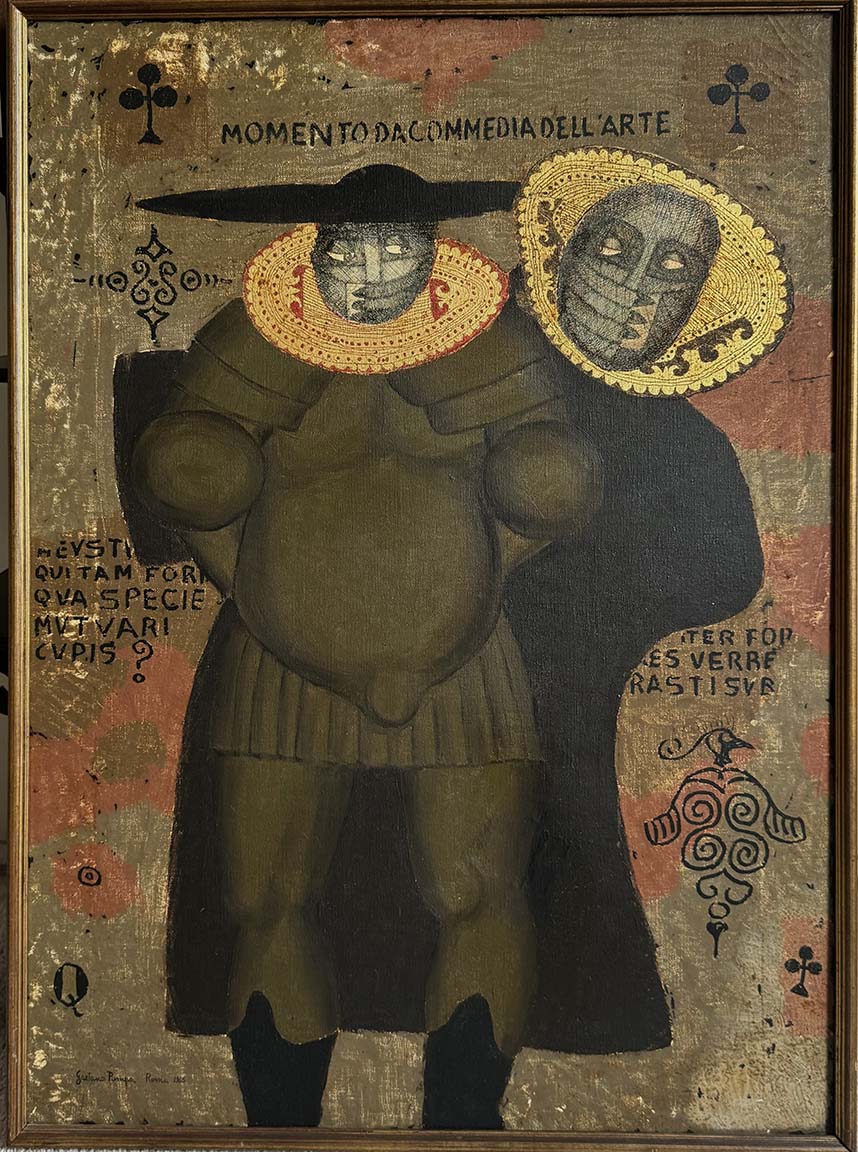

GAETANO POMPA
"COMMEDIA DELL ARTE"
OIL ON CANVAS, SIGNED
ITALY, DATED 1965
43 X 31 INCHES
SOLD
Gaetano Pompa was born in Forenza, Lucania, in 1933. He spent his childhood between Forenza and Tarquinia where, through the family’s friendship with Professor Romanelli, he had access to Etruscan-Roman archaeological sites in the Tuscia and Maremma areas.
At the end of the war he moved to Rome where he became passionate about life drawing and attended the studios of Gastone Biggi and Assen Peikov. He continued drawing even during his military service (1955-56),
carried out first in Orvieto and then in Sulmona, where he made numerous sketches and studies of comrades and landscapes.
Returning to Rome, he devoted himself to painting and engraving and got to know some of the leading figures on the Roman scene, including Gianni Novak, Andrea Picini, Mimmo Rotella, Paolo Buggiani, Mario Schifano, Tano Festa, and Franco Angeli.
In 1957 he inaugurated his first solo exhibition at the L’Obelisco Gallery in Rome, where he met colleagues and friends Gustavo Foppiani and Domenico Gnoli. He started a close collaboration with Gaspero Del Corso and Irene Brin with whom he exhibited regularly in Italy and abroad, taking part in the main institutional
exhibitions of the 1960s.
From 1958 to 1961 he lived in Munich, in the Schwabing district, where he carried out an intense intellectual and artistic activity, becoming passionate about the cultural and musical life of the Bavarian city. He simultaneously entertained a lively exchange with the sculptor and painter Emilio Greco and began to become interested in ceramics.
In 1961 he married Dorothea Leendertz, a photographer who graduated from the Münchner Fotoschule, whom he met while in Munich; together they have five children.
In Rome he often attended the German Academy’s Villa Massimo circle, near his studio on Via Nibby. He established deep relationships of esteem and friendship with a number of intellectuals including Max Frisch, Ingeborg Bachmann, Tankred Dorst and Uwe Johnson. The latter will inspire the title of the Mutmassungen series of works.
In 1964 he presented an exhibition of ten large canvases entitled The Tenth Commandments at the Obelisk. The same exhibition is shown again at Knoedler Gallery in New York with a preface by Max Frisch. The collaboration with Knoedler, through Del Corso, establishes an intense relationship with American collecting that will continue throughout the 1960s.
He participated in the IX Quadriennale Nazionale d’Arte in Rome and the VI Biennale in Paris in 1965 and two editions at the Carnegie International in Pittsburgh in 1964 and 1967.
In 1970 he executed the sets and costumes for Gioacchino Rossini’s ‘Elizabeth, Queen of England’ directed by Mauro Bolognini, staged in 1971 at the Teatro Massimo in Palermo and at the Aix En Provence and Edinburgh festivals. The following year he inaugurated an anthological exhibition of his sculptural production-from 1964 to 1972-at the Obelisco, with a catalog edited by Enzo Carli
and Fortunato Bellonzi. He also worked on new projects with Mies and Mario Apolloni’s Galleria Rondanini and with the dealer Paolo Sprovieri, with whom he collaborated continuously until the late 1980s.
Since 1974 he spent part of the year in Maremma, in Ansedonia – a land to which he dedicated numerous series of works- working in the house-studio where he regularly frequented colleagues and friends including Carlo Guarienti, Riccardo Tommasi Ferroni, Mario Schifano and Franco Angeli.
In 1977 he received the Vatican commission for the episode of St. Paul’s life on the occasion of the LXXX genetliaco of Pope Paul VI.
In the 1980s he exhibited frequently in Rome, Brindisi, Bologna and Venice, followed by Vittorio Sgarbi who invited him to participate in several group shows. In 1993, at the invitation of Fabrizio Clerici, an anthological exhibition was inaugurated at the Accademia di San Luca in Rome. Two years later Enzo Carli organized the retrospective exhibition at Palazzo Piccolomini in Pienza.
The work of Gaetano Pompa turns out in his entire production to be an autonomous work. The first informal works gradually give way to a new figuration that proceeds parallel in the production of painting, sculpture and ceramics, as in drawing and engraving. Pompa gives form to the suggestions he receives and from the reflections he formulates on characters from ancient history, reading chivalric and epic poems, taking an interest in sacred literature and oriental culture, equally fascinated by the figures of Frederick Barbarossa and Julian the Apostate, geishas and knights, Ezra Pound and Igor Stravinsky.
His works are part of various international collections and institutions including: Museum Kunstpalast, Düsseldorf; John Herron Art Museum, Indianapolis; Art Gallery of Ontario, Toronto; Rembrandt Art Center, Johannesburg; Galleria d’Arte Moderna, Genoa; MoMa, New York; Graphic Collection University of Glasgow; Vatican Museums, Vatican City.